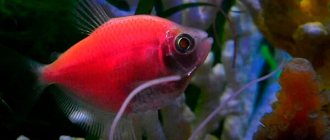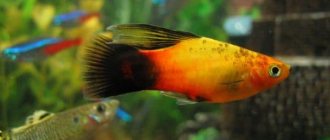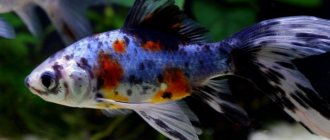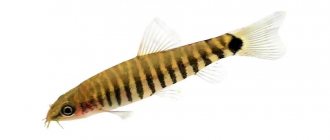Shark baloo (lat. Balantiocheilos melanopterus) is a fairly large aquarium fish. The peculiarity of its keeping is that the shark baloo prefers to live in a school and is quite voracious, although it is not a predator. The fish got its name for its slight resemblance to sharks, although there is no real connection between them.
At least not so small that a baloo could swallow them. This is a fairly strong fish and does not require feeding.
They will look great in the middle layer of water if the right conditions are created.
Habitat in nature
The Balantiocheilus melanopterus was described by Peter Bleeker in 1851. It lives in Southeast Asia, Sumatra and Borneo and the Malay Peninsula.
Previously it was stated that the birthplace of the fish is in Thailand in the Mekong River basin. However, in 2007, a refutation was published proving that the species does not occur in this region.
The species is listed in the Red Book as an endangered species. The number of fish in nature is constantly decreasing for reasons that are still unclear.
There is no evidence that this occurs as a result of catching for the needs of aquarists; most likely, the disappearance is the result of environmental pollution.
The fish that go on sale are exported from Thailand and Indonesia, where they are bred on farms using hormonal agents.
The natural habitat is medium and large rivers, as well as lakes, for example Danau Sentarum in Borneo.
Baloo is a pelagic species, that is, it inhabits all levels of water, and not bottom or top. They feed mainly on small crustaceans, rotifers (microscopic aquatic animals), insects and insect larvae, as well as algae and phytoplankton.
Reviews
I recently purchased several young fish - Balu sharks. Already have experience with maintenance. I carefully measured out the food, as I was afraid of overfeeding. As it turns out, if a fish touches the ground and tries to look for food there, it means it is starving. I increased the dose and the behavior returned to normal. The only drawback noted is incompatibility with slow-moving fish - angelfish are in shock... Lyudmila, 31 years old, Krasnodar
Barbus is a very beautiful and active fish for the aquarium. It requires a lot of space, but this is not surprising - it constantly rushes between the algae, looking for food. Expectation/reality - 5 out of 5. Marina, St. Petersburg
I purchased several Balu sharks and decided to make my own food. As a result of the actions, several representatives became ill with gill rot. It turned out that the cause of infection in most cases is live food. I cured it, now I feed it from the store, all the fish are healthy and happy. Andrey, 26 years old, Rostov-on-Don
Description
A freshwater fish, it is not related to sea sharks. In English they call it bala shark. It's just a convenient commercial name to boost sales.
The fish has an oblong, torpedo-shaped body, large eyes, adapted for constant search for food. The dorsal fin is high and raised, which gives the fish its name.
Large fish reaching 35 cm in length in nature. In an aquarium up to 30 cm. Life expectancy up to 10 years with proper care.
The body color is silver, slightly darker on the back and lighter in the belly area. The fins are striped with white or yellow and end with a black edge.
The difference between a male and a female
Among young fish it is simply impossible to distinguish them; differences begin to appear only after the fish reach 14 cm, almost after four years of life. The female's abdomen becomes rounded, and the males become much more cocky and look larger than the females. Most of their holders believe that the Balu does not have sexual dimorphism.
Immediately before spawning, you can notice a kind of dance between them.
Content complexity
The fish is very strong and lives well with normal care. It is very easy to feed as it eats everything. Greedy ones, it’s better not to overfeed.
The biggest problem with maintenance is the size. They grow very large and quite quickly, and also outgrow the size of the aquarium.
This is a schooling fish and must be kept at least 5 individuals. Like all schooling fish, a strict hierarchy is observed in the school. If you keep less than 5 individuals in an aquarium, the less dominant ones will constantly suffer.
Fish kept alone in an aquarium can become aggressive to the detriment of other species.
These are active but shy fish; they need a lot of free space for swimming and at the same time plants for shelter.
Given their size and schooling habits, they require very large aquariums to keep them. For juveniles, an aquarium of 300 liters is the minimum, but when they become sexually mature, an aquarium of 400 or more liters is needed.
The aquarium must be closed, as they are capable of jumping out of the water and often do this.
Price
Balantiocheilus is rarely found on sale in markets. Such fish are most often purchased in pet stores on order or via the Internet.
| Size, cm | Average cost, rub. |
| 2-3 | 150 |
| 3-5 | 195 |
| 5-7 | 250 |
| 7-9 | 450 |
| 12-15 | 700 |
| 20 | 1000 |
Shark barbs grow quickly, and the aquarist will not have to wait long if he buys small fry.
Feeding
The fish eat all types of food. In nature, it feeds on insects, larvae, algae and plant particles.
All types of live and artificial food are eaten in the aquarium. For successful growth, it is better to feed high-quality dry food daily and add brine shrimp or bloodworms.
They love bloodworms, daphnia, and vegetables. You can add green peas, spinach and chopped fruits to your diet.
Large individuals love protein foods - cut worms, shrimp and mussels. It is best to feed them two or three times a day, in portions that they can eat in two minutes.
What to feed a shark barb
In nature, the Bala shark eats insect larvae, algae, worms, and living plants. He has a good appetite, but a weak stomach. It is not recommended to feed them bloodworms in an aquarium, as it leads to digestive upset.
For feed, choose high-quality dry, slow-sinking feed. TetraMin Granules are suitable for young animals, and TetraMin XL Granules for adults. These feeds slowly get wet and sink. Therefore, the fish will be able to eat them in the water column.
You can supplement your diet with TetraPro Energy flakes for active fish and frozen brine shrimp. A couple of times a week, give the fish vegetables soaked in boiling water: lettuce, zucchini, cucumber, pumpkin.
Feed your pets in the morning and evening in small portions.
Female
Keeping in an aquarium
Shark baloo is a large, active and schooling fish that spends its time constantly moving around the aquarium, especially in open areas.
It's better to create the conditions for this before you buy it. For juveniles, an aquarium volume of at least 300 liters is needed, but over time it is better to double the volume.
Since they swim very actively, the length of the aquarium should be very large, ideally from 2 meters. The aquarium should have good filtration and flow, with high levels of oxygen in the water. You need a powerful external filter and a lid, as fish jump out of the water.
Covers don't matter to them. It is better to have a spacious aquarium with plenty of space for swimming.
The dark back wall and soil will make the shark barb look more impressive. The aquarium water needs to be kept clean as it is a river fish and needs good water.
The main requirement is regular water changes. The aquarium is a closed system and requires cleaning. Accumulating organic substances pollute the water and poison it, but the shark is a river dweller accustomed to clean water.
A 25% water change weekly would be ideal.
The decor for the contents does not matter; what is more important is the availability of free space for swimming. For decoration, you can use plants along the edges of the aquarium and driftwood in the middle.
One of the benefits of keeping these fish is that they constantly search for food on the bottom, helping to keep it clean.
Although they lift food from the bottom of the aquarium, they do so elegantly without stirring up the water.
They can also make sounds.
Recommended water parameters:
- pH 6.0–8.0
- 5.0–12.0 dGH
- water temperature 22–28°C (72–82°F)
Diseases
Like all living beings, energetic and fast-moving fish get sick. Often, their diseases arise due to improper feeding or violation of the lighting regime, since daylight hours determine the functioning of the metabolism of underwater inhabitants. But in general, Balus are hardy, although there are a few very common diseases.
Gill rot
An infectious disease caused by a fungus. The vessels in the gills become clogged and then destroyed during natural metabolic processes. Hemorrhages in the area of the respiratory organs - redness of the gills , make it possible to notice the disease. Characterized by loss of appetite, decreased reactions to stimuli, being near the surface of the water and friction against solid objects. The fish dies lying on its side. As a preventive measure, rivanol (2 mg/l) is added to the water once every three months.
Dropsy
The abdomen is swollen, the scales are puffy, and general lethargy is observed. Occurs due to violations of containment conditions. It is impossible to cure with the current level of technology development; fish with severe symptoms must be destroyed.
Obesity
Occurs due to feeding errors. Individuals increase in size, apathy and decreased motor activity can be noticed. It is worth taking action when you notice large weight gains coupled with other symptoms. For treatment, barbs are left without food for two days, after which a balanced diet is introduced.
Rubella
Appears when infected individuals are introduced without being quarantined or after feeding stale food. It appears in the form of red spots and open sores on the body , the anal fin begins to rot, and the animal refuses to feed. For treatment, you will have to purchase anti-infective drugs from pet stores and use them in accordance with the instructions.
Fin rot
The main cause of fish disease is contaminated water and infrequent cleaning. Symptoms: blue edging on the fins, which was not there before, unnatural color, loss of rays, clouding of the eyes, decomposition of the swimming organs. For treatment, you should increase the water temperature by several degrees, replace the water and add 0.15 g/l streptocide.
Proper care will protect the inhabitants of the aquarium from diseases.
Compatibility
Shark baloo, as already mentioned, is a fairly peaceful fish and gets along with other fish of equal size. But keep in mind that this is a large species and although it is not predatory, it will eat small fish.
By small we mean: neons, guppies, rasboras, microrasboras galaxy, zebrafish and others.
Gets along with the same large species, which are the same in character, since the fish are large and active, some types of fish can be annoying.
They are interesting to watch, but the fish are shy. Be sure to keep a flock of at least 5 individuals. The flock has its own hierarchy, and, unlike keeping pairs, it is more balanced and less aggressive.
Features of behavior
Almost all shark barbs sold in pet stores are caught from natural bodies of water. Almost no one is engaged in their artificial breeding. Such fish are not adapted to life in an aquarium and at first behave inappropriately.
The adaptation period for the shark ball takes at least a month, and only then, gradually, does it begin to get used to its new home. From any sudden movement or knock, this new resident begins to rush and hit the glass and decorations. There are cases when a baloo jumped out of an aquarium if it was not closed at the top. This fish is so timid that it can die of fear in the literal sense of the word.
These fish should be kept in schools.
Shark barbs feel more comfortable in a school, so it is recommended to keep several individuals together (from 5 pieces) . It is interesting that a strict hierarchy is built in the flock and observing their behavior and relationships is extremely entertaining.
The shark barb is a fairly peaceful aquarium resident, except for the spawning period. Compatibility with other types of fish is determined, first of all, by size: if they are the same or slightly larger, they will get along quite well. Among the popular species, the following fish can become good neighbors of the shark ball:
- other types of barbs;
- gourami;
- minors;
- rasboras;
- iris;
- tetras;
- catfish.
It is not recommended to keep shark balus with aggressive territorial cichlid species, since the latter, even if of equal size, can drive them to death. Phlegmatic fish, such as angelfish, will be very irritated by restless and active balus.
Even a short-term stay of a school of shark barbs among veiled fish is very undesirable. Due to their temperament, balus will pester them and bite their long fins and tails.
Although this species is not considered a predator, its coexistence with small viviparous fish, neons, zebrafish, and microrasboras can end sadly. Everything that the Balu can swallow, he will swallow.
Breeding
Although there are reports of successful aquarium breeding of Balu sharks, the majority of commercially available fish come from farms in Southeast Asia. It is much easier to purchase this fish than to breed it.
First of all, remember that a sexually mature male grows up to 30 cm, and it is not recommended to keep him in aquariums smaller than 400 liters in principle.
If you keep several fish, then 600 liters or more. Despite its size, it is a fairly peaceful fish, but breeding it is difficult.
Unlike many small fish that become sexually mature at an early age, the shark baloo does not mature until it reaches 10-15 cm.
It is very difficult to accurately determine the sex of a fish; based on this score, keep a flock of 5-6 individuals. Males grow somewhat larger than females, and females have a slightly rounder belly.
It will take a long time before you can roughly determine the sex, and even experienced aquarists make mistakes.
To prepare the fish for spawning, prepare an aquarium of 200-250 liters, with a water temperature between 25-27 C. Do not plant tightly with plants, the fish need a lot of space to swim.
It is better to have several large bushes of plants in the corners. If you plan to raise the fry in the same aquarium, then it is better to leave the bottom clean.
This bottom is easier to clean and easier to observe the eggs. To keep the water clean, install an internal filter with one sponge, without a lid. This filter cleans the water quite well and does not pose a danger to the fry.
It is believed that before spawning, the male and female perform a kind of dance. At least the breeders believe that the mating dance takes place.
After the female has laid eggs, she flies them around the aquarium so that the male can fertilize the eggs with milk. In order to increase the chances of fertilization, it is important to have a current in the spawning area, which will spread the milk over a larger area.
Once the spawning is over, the male and female do not pay any attention to the eggs. In nature, balus join various flocks for mating and, accordingly, do not care for the eggs in the future.
Parents tend to eat the fry and the game, so after spawning they need to be removed immediately.
Nuances during reproduction
In aquariums, fish reproduce very rarely and reluctantly. This process is expensive, long and often fails without special hormonal injections. Firstly, the fish will reach sexual maturity only at four years of age. And secondly, you will need a special spawning tank of a fairly large capacity (1200 liters minimum) with a length of at least two meters, where two mature males and one mature female are placed.
Make the water in the spawning tank colder, but softer than in the main aquarium (then you need to increase the temperature), cover the bottom with a thick layer of moss or mesh. It is advisable to feed the female with rich plant foods, and the males with rich protein and animal foods.
During spawning, one individual produces 10 thousand eggs. Then the fish need to be transplanted back. To protect against fungal diseases, it is recommended to add methylene blue (or another antifungal drug) at this stage. On the third day, methylene blue is removed with the help of coal. The appearance of the fry can be expected in two days, and after three days they are already swimming in a school and willingly eating living dust. Not every aquarist will decide on such complex breeding and further care. Many admit that it is much cheaper to buy or order them specially.











